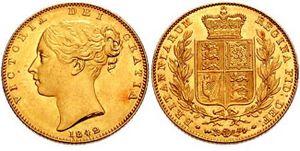Gresham's law facts for kids
Gresham's law is a simple idea about money. It's often said as: "Bad money drives out good." This means that if there are two types of money with the same face value, but one is seen as "better" (perhaps because it has more valuable metal), people will tend to keep the "good" money and spend the "bad" money. Over time, the "good" money disappears from everyday use.
This law is named after Sir Thomas Gresham (1519-1579). He was an English merchant and financier. Sir Thomas Gresham also founded the Royal Exchange in London in 1565.
How Gresham's Law Works
Imagine you have two coins that are both worth one dollar. One coin is made of valuable silver. The other coin is made of cheaper metal. Both coins can buy the same things.
If you need to buy something, which coin would you spend? Most people would spend the cheaper metal coin. They would save the valuable silver coin. This is because the silver coin's metal is worth more.
Over time, the valuable silver coins would become rare in stores. People would keep them at home. Only the coins made of cheaper metal would be used for shopping. This is how "bad money" (the cheaper coin) pushes out "good money" (the silver coin).
Real-Life Examples
A great example of Gresham's law happened with silver coins. In Canada (until 1968) and the United States (until 1964), many coins were made of real silver. These included dimes (ten cents) and quarters. Half dollars had silver until 1970.
However, these countries later started making their coins from cheaper metals. The new coins looked similar but had less valuable metal. What happened next?
People quickly noticed the difference. They started saving the older, silver coins. They spent the newer, cheaper coins. Soon, the silver coins almost completely disappeared from daily use. They were hoarded by people who valued their metal content.
This process also happened with copper coins. For example, the Canadian penny before 1997 had more copper. The United States penny before 1982 also had more copper. Older UK copper pennies and two pence coins (before 1992) are another example. As the price of copper went up, people started saving these older coins. They spent the newer coins made with less copper.
Even coins made of less expensive metals, like steel in India, have shown this effect. If a new, cheaper version of a coin is introduced, the older, slightly more valuable version tends to disappear from circulation.
Images for kids
-
A stack of twenty Walking Liberty half dollars (left), which contain 90% silver. In an example of Gresham's law, these coins were quickly hoarded by the public after the Coinage Act of 1965 debased half dollars to contain only 40% silver, and then were debased entirely in 1971 to base cupronickel (right).
See also
 In Spanish: Ley de Gresham para niños
In Spanish: Ley de Gresham para niños



